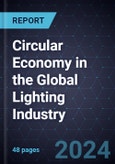Decarbonization Efforts and Sustainability Goals Drive Transformational Growth Opportunities
Natural resource scarcity, the harmful environmental impacts of emissions, and discarded materials in landfills and water bodies are pressing global challenges. The lighting industry significantly contributes to eWaste and pollution, including greenhouse gases and used materials from parts. This challenge warrants adopting circular economy principles over the prevailing linear economy models in every stage of any industry’s supply chain. The circular economy is an alternative economic model that focuses on reducing waste and pollution by promoting product reuse, repair, and recycling. The circular economy is significant in the lighting industry for several reasons, as it addresses various environmental, economic, and social challenges associated with traditional linear economic models, such as resource efficiency, waste reduction, and energy conservation.
OEMs embrace circular practices to meet regulators’ decarbonization goals and make supply chains and manufacturing practices sustainable and cost-effective in the long run. By integrating circular economy principles into the lighting industry, companies can contribute to sustainability, reduce waste, and create a more environmentally friendly approach to manufacturing and consumption. This approach aligns with broader efforts to build a more sustainable and resource-efficient global economy.
This analysis provides an overview of the current circular economy practices in the lighting industry. It identifies and explores the most essential practice areas and derives meaningful conclusions about the state of circular economy adoption in the lighting industry.








